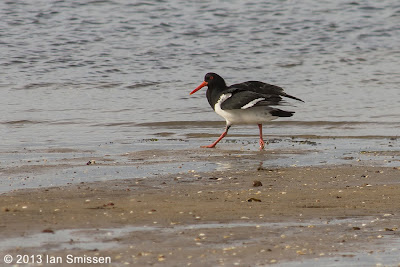Last day of winter today but it felt much more like spring, with mild sunny weather and a light wind, so it looked like a good day to visit the Brisbane Ranges. August is wattle month in the ranges with the Golden Wattle in full flower creating splashes of yellow all over the under-storey at many locations.
 |
| Golden Wattle, Brisbane Ranges NP |
The floral abundance and nesting season for many birds meant that lots of the usual suspects were active and easy to find.
First stop was The Crossing Picnic Area and, immediately I was out of the car, the familiar twittery
Red-browed Finch chatter surrounded me. Luckily, I had already assembled the camera, tripod and flash so I managed to fire off a couple of shots with and without flash.
 |
| Red-browed Finch, The Crossing Picnic Area, Brisbane Ranges NP |
This was to be a familiar theme for the rest of the day as I tried shooting with and without flash whenever I could manage it.
 |
| Golden Whistler (female), The Crossing Picnic Area, Brisbane Ranges NP |
I found this Eastern Yellow Robin while I was stalking a Golden Whistler at the next stop (Graham's Creek Picnic Area) after spotting a flash of yellow in the tree just in front of me.
 |
| Eastern Yellow Robin, Graham's Creek Picnic Area, Brisbane Ranges NP |
I didn't manage to find the whistler but did see why the robin was so active right beside the path when, on my way back, I discovered its nest on the back of the same tree in which I'd photographed it on the way up the track.
 |
| Easter Yellow Robin, Graham's Creek Picnic Area, Brisbane Ranges NP |
I took a couple of quick shots and then skirted around the tree leaving the bird in peace.
Stony Creek Road runs along the north-eastern boundary of the park and offers some great opportunities for birding in the roadside vegetation.
 |
| Eastern Spinebill, Stony Creek Road, Brisbane Ranges NP |
 |
| White-throated Treecreeper, Stony Creek Road, Brisbane Ranges NP |
Last stop was Anakie Gorge, where I found a
Spotted Pardalote and then a
White-naped Honeyeater stripping bark from a eucalypt trunk and they were both quite oblivious to my close approach
 |
| Spotted Pardalote, Anakie Gorge, Brisbane Ranges NP |
 |
| White-naped Honeyeater, Anakie Gorge, Brisbane Ranges NP |
and, of course, the ubiquitous
Superb Fairy-wrens were noisily guarding territories and gathering food.
 |
| Superb Fairy-wren, Anakie Gorge, Brisbane Ranges NP |
I still need to work on flash settings and when to use (and not use) the Better Beamer. The flash certainly makes the images clearer and more vibrant than natural light and freezes the action well but it appears unnatural on many occasions and with the Better Beamer on, the flash reflection in the eye needs post production work to remove the large catch light.











































